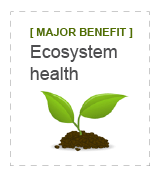Adopt development ordinances or processes that protect natural systems and valued community assets.
Laura Musacchio, University of Minnesota, Department of Landscape Architecture: 612/626-0810, musac003@umn.edu


- Nature-based solutions - solutions that involve working with nature to address societal challenges - have gained momentum as a tool that can deliver multiple benefits.
- Maintaining or restoring native vegetation and protecting natural systems sequesters carbon and limits the release of stored carbon.
- Well-managed open lands and rural development, whether fields, forests, agriculture lands, parks or wetlands, help sustain biodiversity, ecosystem services, and the community in a variety of ways, including:
- Reduced volume of stormwater runoff, surface water pollutants and sediment
- Enhanced groundwater recharge
- Reduced erosion
- Improved air quality
- Additional wildlife habitat and recreational space
- Preservation of rural community character and viewsheds
- Properties near open space and functioning natural systems show strong retention of housing values over time.
- Linking housing to green space results in increased bicycle and pedestrian travel, helping meet active living goals and encouraging non-motorized modes of travel.
- Landscapes can be planned, designed, developed and maintained to protect and enhance the benefits society derives from healthy functioning landscapes. The Sustainable SITES Initiative and it's rating system provide performance measures of the degree to which development protects natural systems and valued community assets.
- This best practice is consistent with the MN DNR's shoreland model ordinance, which defines shoreland conservation that reflects the latest stormwater management practices, values open space, buffers and provides standards for shoreland conservation subdivisions.
- The MN Solar Sanctuaries Act of 2016 establishes voluntary native vegetation and habitat management practices in the footprint of solar installations.
Optional Best Practice for Step 3 Recognition
Category A, B and C cities: implement this best practice by completing any one action.
The primary goal of conservation design is to conserve natural or economic, cultural, historic resources or community character through low-impact development techniques, coupling development and restoration efforts. Rural conservation design protects agricultural practices, working forests, or open space for rural community character. Transitional conservation design creates a permanent urban-to-rural transition (transect) that maintains rural character and buffers rural economic uses from urban development. Natural resource conservation design protects or restores valuable natural systems - habitat and local biodiversity - viewsheds, and a community's natural resource heritage where these resources are in potential conflict with development. Conservation design actions retain or expand ecologically healthy woodlands, wetlands and open lands that infiltrate rainwater, sequester carbon, and contribute to community resilience to climate change. These actions also aim to lower development costs, decrease maintenance costs, preserve more usable natural areas, and protect surface and ground water when compared to the traditional models of development.
